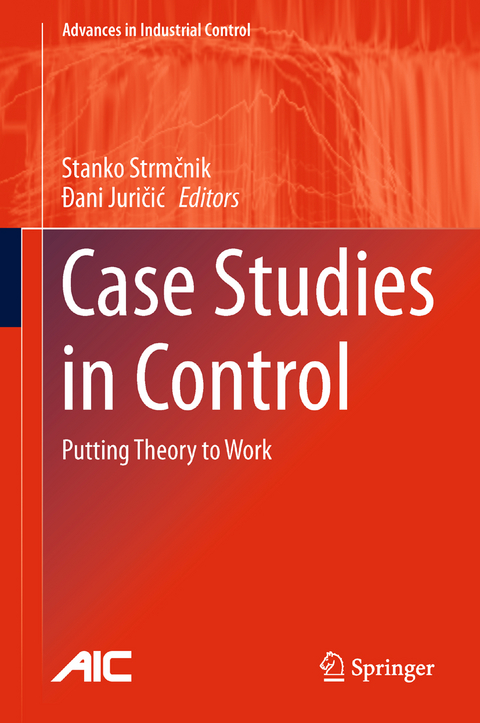
Case Studies in Control
Springer London Ltd (Verlag)
978-1-4471-5924-7 (ISBN)
Following the illustrations of the progress that can be made from either extreme of the well-known theory–practice divide, the text proceeds to a third part related to the development of tools that enable simpler use of advanced methods, a need only partially met by available commercial products.
Each case study represents a self-contained unit that shows an experimental application of a particular method, a practical solution to an industrial problem or a toolkit that makes control design and implementation easier or more efficient. Among the applications presented are:
wastewater treatment;
manufacturing of electrical motors ;
temperature control of blow moulding;
burn-protective garments quality assessment; and
rapid prototyping.
Written by contributors with a considerable record of industrially-applied research, Case Studies in Control will encourage interaction between industrial practitioners and academic researchers and be of benefit to both, helping to make theory realistic and practical implementation more thorough and efficacious.
Advances in Industrial Control aims to report and encourage the transfer of technology in control engineering. The rapid development of control technology has an impact on all areas of the control discipline. The series offers an opportunity for researchers to present an extended exposition of new work in all aspects of industrial control.
Stanko Strmčnik joined the Jožef Stefan Institute, the leading Slovenian research institute in the field of natural sciences and engineering, in 1973. Since 1986 he has been head of the Department of Computer Automation and Control (later renamed the Department of Systems and Control) at the same institute. He is also a professor at the Faculty of Electrical Engineering, University of Ljubljana and at the School of Engineering and Management, University of Nova Gorica. During his career he has been involved in numerous research-and-development projects as well as various industrial applications. His research interests involve mathematical modelling, identification, optimal control, predictive control, PID tuning, process control, non-technical aspects of automation and technology transfer. He initiated and led the development of various tools and building blocks for control system implementation, e.g., SIMER – a microcomputer-based data-acquisition and control system, ANA – a universal computer-aided control systems design tool, MMC-90 – a microprocessor multi-loop controller, and ASPECT – a PLC-based system for advanced control. He was also deeply involved in some large industrial engineering projects, among them combustion control in boilers and industrial furnaces, the computer control of pulp cooking, and the computer control of titanium dioxide production. Đani Juričić is a research fellow at the Jožef Stefan Institute and a professor of electrical engineering at the University of Nova Gorica. For almost 30 years he has been active in applied research in automatic control through numerous research grants and projects for industry, in the majority of which he acted as project leader. His research interests include condition monitoring, fault detection, isolation and prediction, the mathematical modelling of dynamical processes, signal processing, system identification, PID and optimal controller design. He has contributed to the CACSDtool ANA, algorithms for the control design of systems with backlash, the control of Wiener systems, PID tuning, modelling for the purpose of control, validation of data-driven models, algorithms for robust control and fault detection, and novel fault-localisation approaches based on approximate reasoning. His notable industrial accomplishments include algorithms for the on-line, model-based control of a pulp cooking process, condition monitoring systems for several processes in the chemical and process industries, a prototype of a system for fault detection and isolation in the production of electrical motors and a system for the on-line supervision of rotational machines and drives.
About the Gap between Theory and Practice.- Part I: From Theory towards Practice.- Identification and Control Using Piece-wise Hammerstein Models.- Tracking Explicit Model Predictive Controllers for Low-level Control Applications.- Divide-and-conquer Method for Analysis and Control of Nonlinear Systems.- Model-based Control of Nitrogen-removal Processes in a Wastewater-treatment Plant.- Part II: From Practice towards Theory.- Temperature Control in a Plastic Extruder Control System.- Tension Control in a Steel-slitting Line.- Final Quality Assessment in the Manufacturing of Electrical Motors.- Model-based Estimation of Burn Injuries.- Part III: Tools and Building Blocks for Control Systems Implementation.- A PLC-based System for Advanced Control.- An Approach to Control Systems SW Development.
| Erscheint lt. Verlag | 16.7.2015 |
|---|---|
| Reihe/Serie | Advances in Industrial Control |
| Zusatzinfo | 112 Illustrations, color; 112 Illustrations, black and white; XVI, 411 p. 224 illus., 112 illus. in color. |
| Verlagsort | England |
| Sprache | englisch |
| Maße | 155 x 235 mm |
| Themenwelt | Mathematik / Informatik ► Informatik ► Theorie / Studium |
| Medizin / Pharmazie ► Physiotherapie / Ergotherapie ► Orthopädie | |
| Naturwissenschaften ► Biologie ► Ökologie / Naturschutz | |
| Technik ► Elektrotechnik / Energietechnik | |
| Technik ► Maschinenbau | |
| Technik ► Medizintechnik | |
| Schlagworte | Burn Injuries • Control Applications • control engineering • Electrical Motors • Model-based Control • Nonlinear Systems • Piecewise Hammerstein Models • Steel Slitting • Steuerungstechnik • Wastewater Treatment |
| ISBN-10 | 1-4471-5924-1 / 1447159241 |
| ISBN-13 | 978-1-4471-5924-7 / 9781447159247 |
| Zustand | Neuware |
| Haben Sie eine Frage zum Produkt? |
aus dem Bereich


